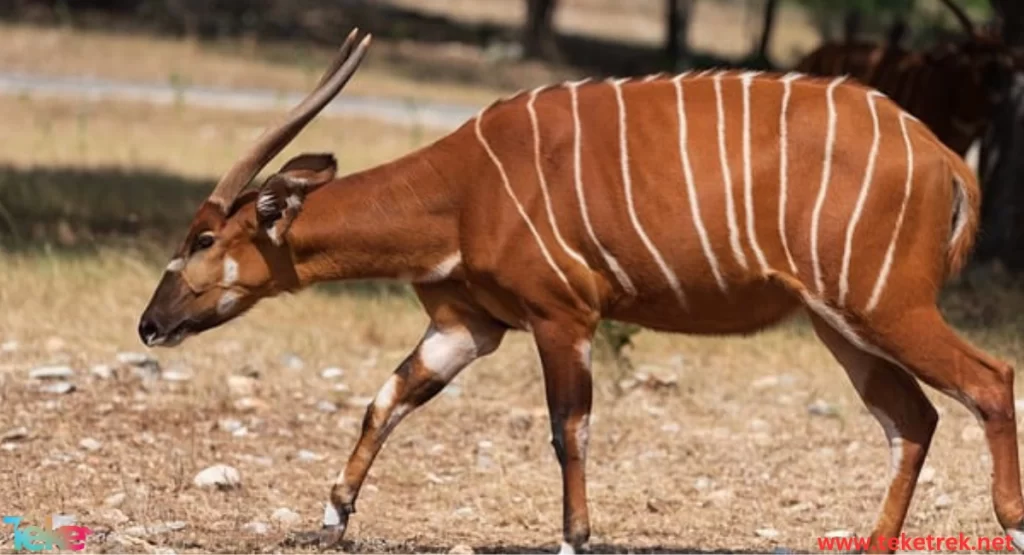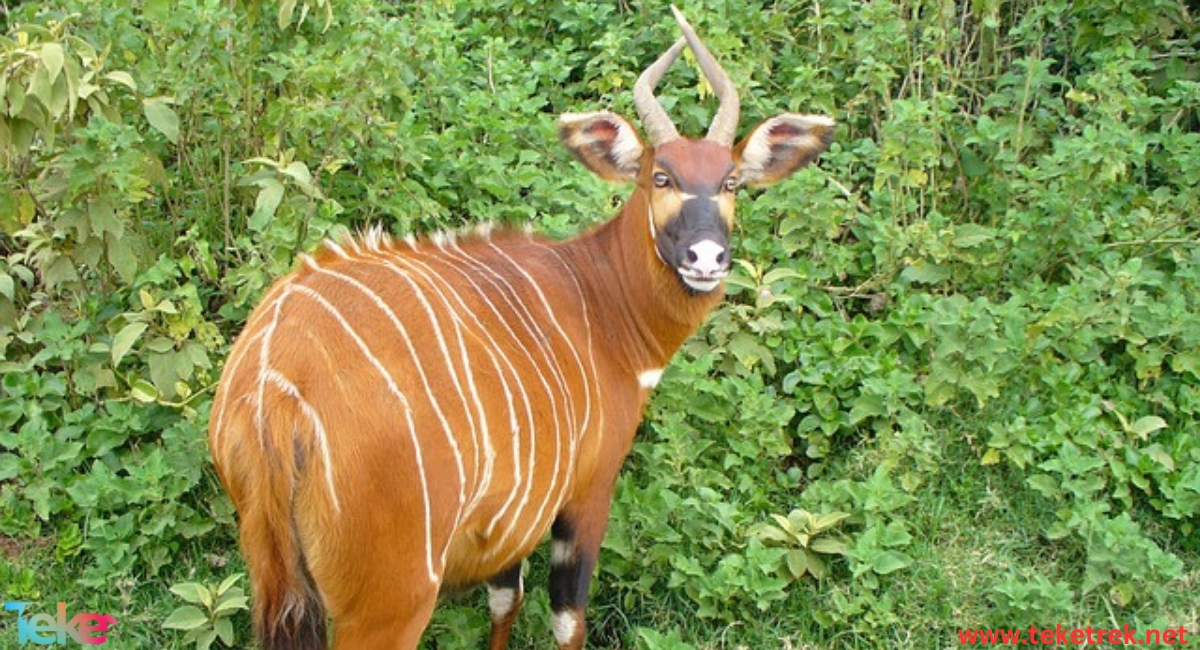The Bongo antelope belongs to the Cordates phylum, the Bovidae family.
Let’s learn more about it from teketrek.

The bongo antelope facts
The Bongo antelope is considered one of the largest antelope species and the most colorful, distinguished by its chestnut coat with white stripes generally along its line.
This chestnut color darkens with age, sometimes turning black.
The Bongo antelope is believed to be very shy and fearful in a peculiar way; when it senses fear, it wants to escape quickly.
The Bongo antelope is elusive and rarely seen, essential for daily life.
The Bongo uses its horns, pressing them against its body when feeling threatened or in danger.
Bongos are social animals that interact with each other mainly during mating season.
Bongos communicate through vocalizations and scent marking when in distress or danger.
The Bongo is the third heaviest antelope after the related Giant Eland and Common Eland.
They are residing in groups of 6 to 8 individuals each.
Bongos have a complex four-chambered stomach aiding in cellulose digestion, compared to other mammals.
They use their legs to break branches or horns to dig for roots.
They are preyed upon by large predators in their surrounding environments, such as leopards and occasionally lions in some regions.
The Bongo antelope specification
Weigh: Males of the Bongo antelope usually weigh between 250 and 450 kg, while females weigh between 210 and 240 kg.
Length: The length of Bongo antelopes’ bodies ranges between 1.70 and 2.50 meters.
Color: The Bongo antelope is characterized by white markings on its cheeks and a distinctive chevron pattern in white between purple.
Legs: Bongos have strong, short legs.
Digestive system: the longest ruminant digestive system.
Ears: They have long, pointed ears and keen predator detection abilities.
Tongue: The Bongo antelope has a tongue that it uses for an extended period before acclimating, easily retaining memories and notes.
Horns: Bongos have distinctive spiral horns, larger and darker in males compared to females, with the spiral horns reaching up to 90 cm.
Age: Bongos can live up to 18 years.
Bongos habitat: Where do bongos live?
The primary habitat of Bongos is in dense forests and swamps in West and Central Africa. They can be found in Kenya, inhabiting bamboo forests and lowland forests.
Although Bongos are present in many parts of Central Africa, they have become rarer in the West.
Bongos food: What do bongos eat?
Bongos are herbivorous animals that feed on plant material and grasses exclusively. They prefer leaves, shoots, and grasses but sometimes search for wood, bark, and even fruits.
They often forage for food at night as it becomes safer than during the day.
Bongos’ subspecies
Bongos have two subspecies
the Mountain Bongo or Eastern Bongo and another type found known as the Western Bongo.
Reproduction stages of the Bongo:
Mating season occurs between October and January, with female Bongos giving birth to a single calf after a gestation period lasting nine months.
The female gives birth in an isolated forest to protect the young from predators, remaining silent for a full week.
The female nurses the calf for an extremely secretive six months.
When the calf grows older, they rejoin the herd for increased protection.
The young Bongo reaches sexual maturity after about two years of age.

FAQs about bongo
How many bongo antelope are left?
With less than 100 left in the wild, they are listed as critically endangered on the IUCN Red list of threatened species.
?What are some interesting facts about the bongo antelope
Both males and females have spiral horns that are shaped like a lyre.
Can you eat bongo?
Bongos are the largest forest antelope. Native people believe if they eat or touch bongo, they will have spasms similar to epileptic seizures. Because of this superstition, bongos have been relatively unharmed in their native ranges.
Is bongo aggressive?
No, they are very shy animals that are mostly active at dawn and dusk.
Does bongo still exist?
Near Threatened (Population decreasing).
After discussing extensively, the information and facts about the Bongo antelope, it is clear that they do not exhibit calm behaviors; females possess enough courage to face predators but are partially fearful.
References:
Wikipedia





